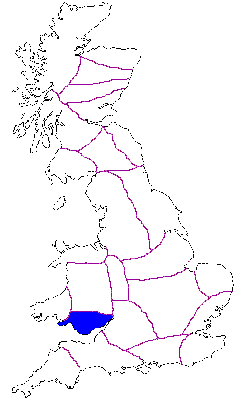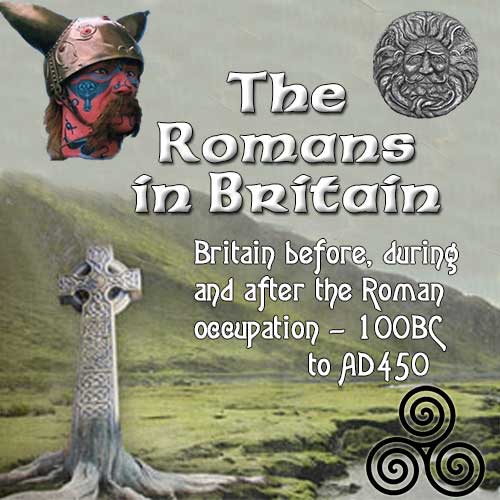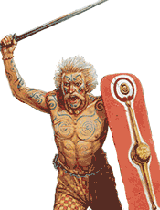The Silures Tribe
Background to the Silures
 Location of the tribe
Location of the tribe
The south east of Wales.
Background information
The tribal name Silures, may itself be one given to the tribes by the Romans. It Latin it means 'the people of the rocks', reflecting to the mountainous region in which they lived. The tribe's people were noted for their aggresive, firey nature and their mass of thick, black curly hair.
Following the short-lived uprisings of the Iceni and the Brigantes in 47, the new governor of Britain, Ostorius Scapula, turned his attention to the Silures.
Legion XX Valeria was probably moved from Colchester to a new legionary fortress at Kingsholm near Gloucester, as the Silures were a volatile race who did not take kindly to the Romans and their incursions into Silures territory. The movement of the XX west left the eastern part of Britain weakened, so a Colonia of veteran soldiers was established at Camulodunum within the confines of the old fortress recently evacuated by the Twentieth Legion
Tacitus:
'Neither severity nor clemency converted the Silures tribe, which continued the struggle and had to be
repressed by the establishment of a legionary camp.'
The reason for the Roman desire to invade and quell the Silures once and for all, was because Caratacus of the Catuvellauni had opposed the full invasion and fled to Wales after the defeat of his tribe.
Tacitus:
'The march then proceeded against the Silures, whose native boldness was heightened by their confidence
in the prowess of Caratacus.'
Tacitus:
'On this occasion, favoured by the treacherous character of the country, though inferior in military
strength, he (Caratacus) astutely shifted the seat of war to the territory of the Ordovices: where,
after being joined by all who feared a Roman peace, he put the final chance to trial'
After his defeat in Wales, Caratacus escaped through the lands of the Deceangi in north-eastern Wales and had sought refuge amongst the Brigantes in northern England. Queen Cartimandua had already agreed a treaty with the Romans in return for being allowed to stay in power as a Client King. On arrival, Caratacus taken prsisoner and passed to the Roman governor, Ostorius. For his part in the capture of the renegade British king, Scapula was awarded the Triumphal insignia, which had in the time of the emperors, replaced the Triumphal procession through the streets of Rome, which was the accepted celebration in the earlier Roman republic.
This was not the end of the Silures, as they continued to show their agression to the next three governors of Britain. The first governor was Aulus Didius Gallus who ruled Britain from 52-57AD. His inititaion into the Silures way of life was immediate.
Tacitus:
'On recieving news of the legate's death, the Caesar, not to leave the province without a governor,
appointed Aulus Didius to the vacancy. In spite of a rapid crossing, he found matters deteriorated, as
the legion³ under Manlius Valens had been defeated in the interval. In this case, again, the loss had
been inflicted by the Silures, and they carried their forays far and wide, until repelled by the advent
of Didius'
Gallus was drawn away from the matters of the Silures by an uprising among the Brigantes.. The Briganties monarchy was in turmoil, and as a client of Rome, Queen Cartimandua called upon the Romas to support her cause in the civil war between her own clan and those loyal to her estranged husband, Venutius, who were unhappy with the Queen's earlier betrayal of Caratacus.
The rule of Gallus was marked by unrest and disorder until he was replaced in 60 AD.
Tacitus:
'Veranius, after harrying the Silures in a few raids of no great significance, was prevented by death
from carrying his arms further.'
The Silures could now live with a lessened fear of the Romans, as there was a more pressing matter to attend to. The Boudiccan rebellion.befell the next governor, Suetonius Paulinus. He may well have made prior plans to completely vanquish the Silures and so end their constant nagging war with the Romans. It was not until the arrival of anothe rgovernpr, Julius Frontinus that the Silures finally succumbed the superior might of the Romans in 76AD.
Tacitus:
'Julius Frontinus was, so far as a subject of the emperor could be, a great man, and he shouldered and
sustained the burden cast on him: his arms reduced the Silures, a powerful and warlike race; he
surmounted not only the valour of the enemy but also the physical difficulties of their land.'
Principal towns and settlements in Silures territory
Venta Silurum - (Caerwent, Gwent)
Other settlements
Blestium - (Monmouth) - Mentioned in the Antonine Itinerary, was probably a fort established in the centre of the iron mining district.
Burrium - (Usk, Gwent) - The only settlement attributed to the tribe by Ptolemy, where it appears as Bullaeum. There was a large fortress here, which was no-doubt accompanied by a settlement.
Cardiff - (Glamorgan) - A settlement outside the Roman fort.
Isca - (Caerleon, Gwent) - A very large settlement was attached to the fortress of the Second Legion.
Llanmelin Wood - (Gwent) - Iron Age camp just north of Venta, may have been the pre-Roman tribal capital of the Silures.
Machen - (Gwent) - Settlement associated with the nearby lead mines under military control.
Redwick - (Gwent) - A small settlement on the Severn estuary, SE of Caerwent.
























